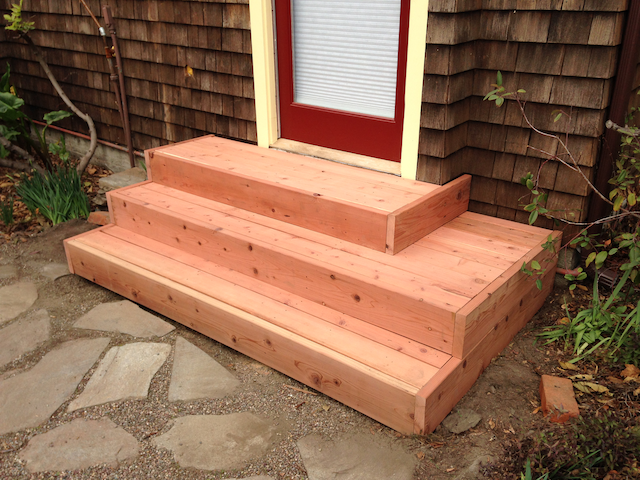Jan 2018
Fences, Gates and Steps. Oh, my!
12/01/18 23:09
I’ve been working with wood for over five decades. I’ve made fine woodworking projects and rough carpentry projects and many things in-between.
Building fences and gates are quite straightforward for me. Steps are always a bit trickier, but I am up to the challenge.
Among my handyman todos I would occasionally run into a client who needed some work on their fences or gates. No problem! I can certainly do that. One of my clients put me into the Berkeley Parents Network as a maker of fences and gates because I did a good job on a section of fence that used to be occupied by a dead tree trunk.
https://www.berkeleyparentsnetwork.org/questions/fence-repair
From that point on I started getting calls to come and estimate fence and gate projects.
There are lots of companies who make fences. According to my clients they have very long waiting lists and tend not to want to work on fences less than 100 feet long. And, they don’t repair fences. So, there are lots of people who need fence work these companies won’t do: an underserved market. I do work on any size fence or gate and I also repair them. I work hourly and I don’t make bids, just estimates. My clients have been loving the transparency I offer in these projects and also the fact that I can beat the big fence companies by about 25% or more. Also, I work with my clients to arrive at a design and cost that they like. Before I ever begin building I am planning to delight my clients with their vision made real. All I need to do is execute according to plan, and I know I can.
So, I’ve modified my site. I’ve added a Fences and Gates page. I’ve eliminated some of my handyman pages with lists of things that frankly, rarely if ever came up. I’ve simply pointed my plumbing section to Matthew Quirk’s Reliable Home Services web site, because he’s been an apprentice plumber and I really don’t enjoy plumbing the way I love building fences and gates.
And steps. Steps are another thing. They seem deceptively simple, but they aren’t. Well, one part of them isn’t. The rest is really very easy by comparison. Cutting the stringers is challenging because all of the complexity of building steps is captured in one difficult to exactly draw shape. I usually use some scrap wood and make a good guess and then perhaps a second approximation that is close enough to trace onto the lumber I’ll use to make the steps. Yes, there is a straightforward theory on how to design steps stringers, and I use that to make my first approximation. But the world full of uneven landings and sloping ground. The stringers might all be subtly different along their base or along their top. They have to be right, and once cut you cannot really change them.
To make things a little harder, this is a three-dimensional problem. The stringers have to line up both in terms of height and in terms of depth. It really is a lot of things that have to be nearly perfect all at the same time. But, with the technique I use I end up with perfect stringers and therefore building sturdy steps is easy once they are in place. Check these out:

Building fences and gates are quite straightforward for me. Steps are always a bit trickier, but I am up to the challenge.
Among my handyman todos I would occasionally run into a client who needed some work on their fences or gates. No problem! I can certainly do that. One of my clients put me into the Berkeley Parents Network as a maker of fences and gates because I did a good job on a section of fence that used to be occupied by a dead tree trunk.
https://www.berkeleyparentsnetwork.org/questions/fence-repair
From that point on I started getting calls to come and estimate fence and gate projects.
There are lots of companies who make fences. According to my clients they have very long waiting lists and tend not to want to work on fences less than 100 feet long. And, they don’t repair fences. So, there are lots of people who need fence work these companies won’t do: an underserved market. I do work on any size fence or gate and I also repair them. I work hourly and I don’t make bids, just estimates. My clients have been loving the transparency I offer in these projects and also the fact that I can beat the big fence companies by about 25% or more. Also, I work with my clients to arrive at a design and cost that they like. Before I ever begin building I am planning to delight my clients with their vision made real. All I need to do is execute according to plan, and I know I can.
So, I’ve modified my site. I’ve added a Fences and Gates page. I’ve eliminated some of my handyman pages with lists of things that frankly, rarely if ever came up. I’ve simply pointed my plumbing section to Matthew Quirk’s Reliable Home Services web site, because he’s been an apprentice plumber and I really don’t enjoy plumbing the way I love building fences and gates.
And steps. Steps are another thing. They seem deceptively simple, but they aren’t. Well, one part of them isn’t. The rest is really very easy by comparison. Cutting the stringers is challenging because all of the complexity of building steps is captured in one difficult to exactly draw shape. I usually use some scrap wood and make a good guess and then perhaps a second approximation that is close enough to trace onto the lumber I’ll use to make the steps. Yes, there is a straightforward theory on how to design steps stringers, and I use that to make my first approximation. But the world full of uneven landings and sloping ground. The stringers might all be subtly different along their base or along their top. They have to be right, and once cut you cannot really change them.
To make things a little harder, this is a three-dimensional problem. The stringers have to line up both in terms of height and in terms of depth. It really is a lot of things that have to be nearly perfect all at the same time. But, with the technique I use I end up with perfect stringers and therefore building sturdy steps is easy once they are in place. Check these out:

